| |

Traditions, folklore, history and more. If it's Irish, it's here. Or will be!
"People will not look forward to posterity who never look backward to their ancestors."
-Edmund Burke




Quotes
Library: Books, Movies, Music
Prints & Photos
Poetry
Jokes


Shops Ireland
Bunús na Gaeilge
(Basic Irish)
Circle of Prayer
Blessings
Did You Know?
Himself/Herself
Write to Us
Readers Write..
Links/Link to Us
Advertise with us
Awards & Testimonials
Submissions Guide

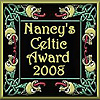
|
|
|
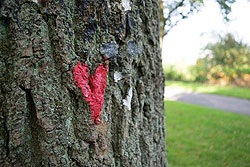 The Irish in love Part 4: Tales of Romance from fact & fiction The Irish in love Part 4: Tales of Romance from fact & fiction
by Bridget Haggerty
For such a small country, Ireland punches far above its weight when it comes to romantic poetry, ballads and plays. But beyond the creative endeavours, there are also many romantic stories to set the heart a flutter. Here are a few of the great ones from mythical legend and real life.
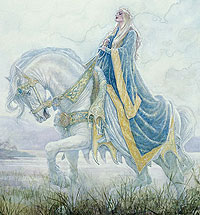 Oisín and Niamh Oisín and Niamh
Oisín, a young hero of the Fianna, gave up everything – his family, friends and country – to be the lover of Niamh “of the golden hair.” He went with her to the land of Tír na nÓg, the land of perpetual youth in the western seas. For three years they lived happily, until Oisín overcome by home-sickness, decided to go back to Ireland for a visit. Niamh, a daughter of the sea-god, lent him her horse which could travel over the waves, but she warned him on pain of death not to dismount and set foot on Irish soil. What Oisín didn’t realise was that three years in Tír na nÓg were the equivalent of 300 years in real time. When he arrived in Ireland Oisín found his family and friends long dead, and his father’s house in ruins. In sorrow he turned his horse back towards the sea, but stopped to help some men clearing stones from a field. He leaned from the saddle to scoop up a boulder, but his stirrup broke and he fell to the ground. The young hero aged 300 years in an instant, died and turned to dust. Instinctively, the horse rode the waves back to Tír na nÓg. On seeing her riderless mount, Niamh knew immdiately what had happened and for the first time, the shadow of tears and grief fell over Tír na nÓg.
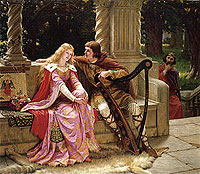 Tristan and Isolde Tristan and Isolde
Tristan was a nephew of King Mark of Cornwall and a valiant, honorable and talented champion. When the King of Ireland sent a champion named Morholt to demand a tribute from Cornwall to fight, Tristan was the obvious choice and defeated him easily. He was badly wounded however, and when he heard that Morholt was returning to Ireland to be healed by a princess named Isolde, he followed in disguise. Tristan praised Isolde’s healing skills so greatly on his return that King Mark decided to take her for his wife, and sent Tristan to fetch her. Isolde’s mother had given the pair a special potion for the journey back, which made them fall deeply in love with each other. Neither could bear to dishonour their respective Kings however, but couldn’t resist each other at the same time, and began a secret love affair. Eventually they were found out and Tristan was exiled, tearing the two apart forever. He reluctantly married someone else and continued to fight, and when he was mortally wounded in a battle some years later, demanded for Isolde to be sent to him to heal him once again. Should she accept and get on the ship, it was to have white sails, and if not, black sails. When the ship arrived his wife, who was always jealous of the love he still had for Isolde, told him the sails were black even though they were white. Tristan died from despair before Isolde could arrive at his bedside, and when she finally did and saw that he had perished, she too died instantly of a broken heart.
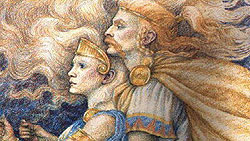 Diarmuid and Grainne Diarmuid and Grainne
The story begins with Ireland’s legendary mythological hero and leader of the band of warriors known as the Fianna, Fionn MacCumhaill. Fionn is tormented with grief after the death of his wife Maignei and in a bid to ease his pain, his followers set out to find him the loveliest woman of all to replace her. They decide that Grainne, the daughter of the High King Cormac MacAirt, is the most worthy woman for the job, and make arrangements for a wedding. Understandably Grainne isn’t too happy about this, especially when she arrives at the betrothal feast and sees that Fionn is older than her father. Instead, she takes a fancy to one of Fionn’s best warriors, Diarmuid. Although he resists her advances at first out of loyalty to his leader, Diarmuid quickly relents without much persuasion after Grainne threatens him with a spell. She gives a sleeping potion to the rest of the unwitting guests at the feast and the two run away together. They cross the river Shannon and hide in a forest, with the help of Diarmuid’s foster father who hides Grainne under an invisibility cloak. Fionn and the rest of the Fianna begin an epic chase but the couple evade them every time in a series of hair-raising scenarios. Seeing that their love for each other is so strong that they will never give up the chase, Fionn is eventually persuaded by Diarmuid’s father to negotiate a peace, and settles for marrying Grainne’s sister instead, leaving the couple to live happily ever after in Co Sligo.
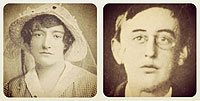 Joseph Plunkett and Grace Gifford Joseph Plunkett and Grace Gifford
Born in 1887 to an affluent Dublin family, Joseph contracted tuberculosis as a child and suffered from poor health for the rest of his life. Unable to engage in active pursuits, he instead turned to books and became extremely well read and well educated, with a particular talent for poetry. His family were supportive of the Nationalist movement in Ireland and Joseph got involved when he came of age, playing a substantial part in the planning of the Rising and the running of the nationalist magazine, The Irish Review. Through the magazine he met Grace Gifford, another creative soul who submitted cartoons and caricatures, and simply put, it was love at first sight. The pair were meant to marry on April 23rd, the day before the Rising began, but in the chaotic events leading up to the day it was postponed. Plunkett was captured and sentenced to death a few days later, having fought in the GPO alongside his comrades. His health plummeted and he was left lying on a mattress by the end of the battle, but the day before his execution on May 4th, Grace came to Kilmainham Gaol and they married there, with only British soldiers pointing bayonets at them as their witnesses. Grace continued to fight for the Nationalist cause after her husband’s death and was even imprisoned in Kilmainham herself during the civil war. She painted on the walls of her cells, and the images are still there today. She never remarried, and when she died in 1955 she was given a funeral with full military honours, with the President of Ireland in attendance.
To hear a song inspired by their love story, please click Jim McCann's Grace.
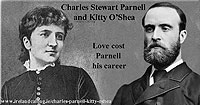 Charles Stewart Parnell and Kitty O’Shea Charles Stewart Parnell and Kitty O’Shea
Charles Stewart Parnell was a renowned politician and public speaker in late 19th century, who campaigned for an end to British rule in Ireland. He was one of the most talented and powerful orators the country has ever seen, amassing huge crowds of followers everywhere he went (he even received a standing ovation from the House of Commons, which was something of a rarity for an Irish politician). He was on the brink of causing major revolutionary change in Ireland when a public scandal broke that made his world come crashing down around him. He had been having an affair with a married woman named Kitty O’Shea for several years, in full knowledge of her husband, Captain O’Shea, and most of London too. The Captain had been waiting for a large inheritance to come through from Kitty’s aunt, but when it never appeared, he filed for divorce. In the 19th century this was virtually unheard of and caused public outcry. Parnell knew this of course, but was unwilling to give up the woman he loved and wanted to be free to marry her, so he let the proceedings go ahead in public for all to see. Naturally, the entire country rapidly lost faith and respect for him and he was forced to give up his political career. His health deteriorated during one last attempt to win back the affections of the Irish people and get re-elected, and he died soon afterwards. 200,000 people attended his funeral, while poor Kitty O’Shea was left to live the rest of her life in relative obscurity and isolation.
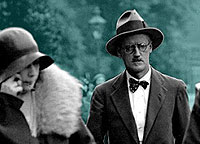 James Joyce and Nora Barnacle James Joyce and Nora Barnacle
Arguably one of the greatest Irish novels ever written, James Joyce’s Ulysses has a lot to do with the woman behind the author – Nora Barnacle. Born in Galway in 1884, Nora had a troubled early life. Largely raised by her grandmother, her mother separated from her alcoholic father and threw him out of their home when she was twelve years old. Her first two loves coincidentally and tragically died while she was a teenager, and at 20, she was asked to leave her Galway home when her uncle discovered her dubious relationship with a Protestant. She moved to Dublin and worked as a chambermaid in Finn’s Hotel, where she met an up-and-coming writer by the name of James Joyce. Although they met on June 10th 1904, their first date was not until a few days later on the 16th. This date was the beginning of a long-lasting relationship that endured through various ups and downs for the couple, including marriage in 1931, a move to continental Europe, two children, one miscarriage, Joyce’s writing and financial struggles, their daughter’s mental illness and internment in an institution, and their naturally opposed personalities and interests. Nonetheless, they stuck with each other through the bad times and the good, and Joyce commemorated their relationship by choosing the day of their first date, 16th June 1904, as the time and setting for his greatest work Ulysses (as well as using Nora herself as inspiration for the character Molly Bloom and her famous soliloquoy). This day is still celebrated every year by Joyce fans, who hold events all over the world to celebrate the writer, his work, and the woman he loved.
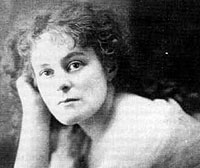 William Butler Yeats and Maud Gonne William Butler Yeats and Maud Gonne
Ireland's greatest ever poet was utterly infatuated by Maud Gonne, a fiery revolutionary who “hurled the little streets upon the great” in Yeats' immortal line during her role in the 1916 Uprising. Unfortunately for Yeats the love was unrequited. They met in 1889 and she turned down all his offers of marriage. Even 17 years later in 1916 after her husband was executed for taking part in the 1916 Rising, he proposed to her again and was refused. At age 52 he proposed to Maud's daughter Iseult Gonne who was 23 at the time. She turned him down as well.
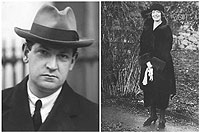 Michael Collins and Kitty Kiernan Michael Collins and Kitty Kiernan
Michael Collins, one of the principal founders of the independent Irish state, was introduced to the vivacious Kiernan sisters by his cousin Gearóid O'Sullivan, who was already dating Maud Kiernan. Collins initially fell for the captivating Helen Kiernan, but she was already engaged to someone else. He then turned his interests to Kitty, who had already captured the interest of Collins' friend Harry Boland. However, it was Collins to whom Kitty became engaged, with plans to marry Collins in a November 1922 double ceremony to include the nuptials of Maud and Gearóid. Tragically, Collins was killed at the outbreak of the Civil War in 1922 which resulted in a single wedding taking place. Kitty married and had a son she named Michael after Collins. She died in 1945 and is buried not far from him in Glasnevin cemetery in Dublin.
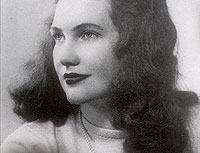 Patrick Kavanagh and Hilda Moriarty Patrick Kavanagh and Hilda Moriarty
Patrick Kavanagh met beautiful, dark-haired Hilda Moriarty in 1944. Originally from Dingle, she was only in Dublin a few months, when she became one of most celebrated beauties of time. She was a trainee doctor; she was also a fan of poetry and literature, which is how they met. Unfortunately, there was too much of an age gap, she was twenty-two and he was forty, so she ended the relationship and married a younger man soon after. In 1946, The song ‘Raglan Road’ was published under the name, ‘Dark Haired Miriam Ran Away.’ But everyone who knew Kavanagh, knew that it was about Hilda. Luke Kelly of the Dubliners couldn’t have interpreted it better when he set the poem to music. He chose the 17th century air: ‘Fáinne Geal an Lae’ (‘Dawning of Day’), as the basis of the song. Either through empathy for Kavanagh’s (still evidently resonant) plight, or from respect for the poem as a brilliant literary work, Kelly immortalised it; his powerful tenor voice reciting it poignantly, and with great dignity.
“On Raglan Road on an autumn day I met her first and knew.
That her dark hair would weave a snare that I might one day rue;
I saw danger, yet I walked along enchanted way.
And I said, let grief be a fallen leaf at dawning of day.”
To hear Luke singing the song he and the Dubliners made famouse, please click Raglan Road.
Sources:
Content:
Claddagh Design/Eileen Moylan
Ireland Calling
Ireland of the Welcomes/The Story of Raglan Road
Wikipedia
Images:
Oisin & Isolde/Ireland of the Welcomes
The Wild Geese/Collins & Kiernan
Main Photo from Claddagh Design
|
|
Fri, Sep 27, 2024
 The Galway Hooker The Galway Hooker
This unique vessel, with its distinctive curved lines and bright red sails, originated in the village of Claddagh. During the 19th century, hookers supported a significant fishing industry and also carried goods, livestock and fuel. Seán Rainey is remembered for building the last of the original boats, the Truelight, for Martin Oliver who was to become the last king of the Claddagh; as king, he was entitled to white sails on his boat. Since the mid seventies, many of the old sailing craft which were on the verge of extinction have been lovingly restored and new ones have been built. During the summer months they can be seen at festivals such a Cruinniú na mBád - the Gathering of the Boats - in Kinvara.
Click for More Culture Corner.
|
Celtic Lovers
by Maire Breatnach
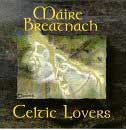
We heard some of this on Mo Cheol Thú - "You Are My Music", the Radio 1 broadcast on Sunday mornings - it is beautiful.
Click here to buy Celtic Lovers.
The Secret Rose: Love Poems of W. B Yeats
Edited by A. Norman Jeffares
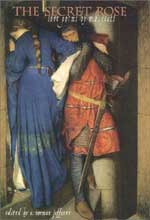
This is a very fine introduction to the life and love poetry of W.B. Yeats. The 48 short poems published here are lovely, touching, and often sad, but have beautifully sculpted lines.
Amazon reviewer.
Click here for The Secret Rose
*The cover of this book is from a painting by Frederic William Burton called The Meeting on the Turret Stairs. The original is in the National Gallery of Ireland, Dublin. A quality print is available from All posters and Prints.
Click here for ...Meeting on the Stairs
|
Includes many old favorites, from Danny Boy to Galway Bay.
Click for Come Back to Erin
|
|
|
|
|




 The Galway Hooker
The Galway Hooker